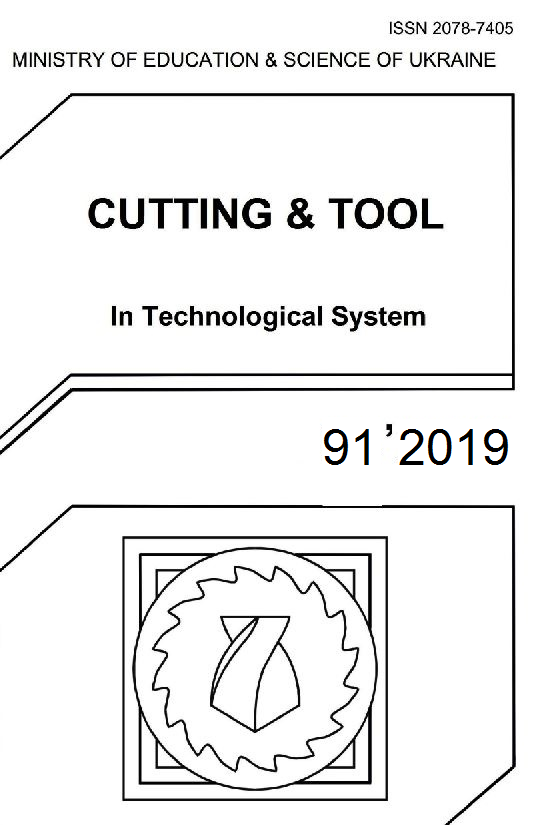STUDY ON MESH DEPENDENCE OF CUTTING ZONE DIMENSIONS PREDICTION DURING ABRASIVE WATERJET MACHINING
DOI:
https://doi.org/10.20998/2078-7405.2019.91.05Keywords:
Abrasive Waterjet Machining, Non-conventional Machining, Finite Element Method.Abstract
Abrasive Waterjet Machining is a non-conventional material removal process, preferred to be used for the cutting of difficult-to-cut materials, due to its ability to remove material without the use of a tool and without causing heat affected zones. Experimentally, monitoring the phenomena taking place in the cutting area is very difficult, due to various reasons such as the high speed of the particles and the obstruction due to the water stream. Thus, a simulation approach, based on experimental data, is required in order to be able to explain these phenomena. In this work, a 3D thermo-mechanical Finite Element model is presented with realistic representation of the positioning of discrete abrasive particles and the dependence of cutting zone dimensions on the mesh size is investigated. After simulation, results are compared to experimental results, mesh independence study is conducted and finally, conclusions on the optimum mesh size are drawn and observed process characteristics are discussed.References
Kun-Bodnár, K., Kundrák, J.: Applicability of Waterjet Cutting for Different Machining Operations, Cutting & Tools in Technological Systems 79, pp. 102-107. (2011).
Kun-Bodnár, K., Maros, Z.: Theoretical Determination of Removed Layer Depth at Abrasive Waterjet Turning, Cutting & Tools in Technological Systems 90, pp. 19-25. (2019).
Maros, Zs.: Machining of different materials with abrasive waterjet cutting, IOP Conference Series: Materials Science and Engineering 012009. (2018).
Maros, Zs.: Effect of load energy on the form of the gap at waterjet cutting, Key Engineering Materials 581, pp. 304-309. (2014).
Kun-Bodnár, K., Kundrák, J., Maros, Z.: Machining of rotationally symmetric parts with abrasive waterjet, IOP Conference Series: Materials Science and Engineering 448, 012053. (2018).
Finnie, I.: Erosion of Surfaces by Solid Particles, Wear 3, pp. 87-103. (1960).
Zeng,J., Kim,T.: An erosion model of polycrystalline ceramics in abrasive waterjet cutting, Wear 193, pp. 207-217. (1996).
Hassan, A.I., Kosmol, J.: Finite element modeling of Abrasive Water Jet Machining (AWJM), Proc. 15th International Conference on Jetting Technology, Ronnby, Sweden, pp. 321-333. (2000).
Gudimetla, P., Yarlagadda, P.K.D.V.: Finite element analysis of the interaction between an AWJ particle and a polycrystalline alumina ceramic, Journal of Achievements in Materials and Manufacturing Engineering 23(1), pp. 7-14. (2007).
Kumar, N., Shukla, M.: Finite element analysis of multi-particle impact on erosion in abrasive water jet machining of titanium alloy, Journal of Computational and Applied Mathematics 236(18), pp. 4600-4610. (2012).
Wenjun, G., Jianming, W., Na, G.: Numerical simulation of abrasive water jet machining based on ALE algorithm, International Journal of Advanced Manufacturing Technology 53(1-4), pp. 247-253 (2011).
Shahverdi, H., Zohoor, M., Mousavi, S.M.: Numerical simulation of abrasive water jet cutting process using the SPH and ALE methods, International Journal of Advanced Design and Manufacturing Technology 5(1), pp. 43-50. (2011).
Jianming, W., Na, G., Wenjun, G.: Abrasive waterjet machining simulation by SPH method, International Journal of Advanced Manufacturing Technology 50 (1-4), pp. 227-234. (2010).
Feng, Y., Jianming, W., Feihong, L.: Numerical simulation of single particle acceleration process by SPH coupled FEM for abrasive waterjet cutting, International Journal of Advanced Manufacturing Technology 59 (1-4), pp. 193-200. (2012).
Hassan, A.I., Chen, C., Kovacevic, R.: On-line monitoring of depth of cut in AWJ cutting, International Journal of Machine Tools and Manufacture 44(6), pp. 595-605. (2004).
Hassan, A.I., Kosmol, J.: Dynamic elastic-plastic analysis of 3D deformation in abrasive waterjet machining, Journal of Materials Processing Technology 113 (1-3), pp. 337-341. (2001).
Johnson, G.R., Cook, W.H.: A constitutive model and data for metals subjected to large strains, high strain rates and high temperatures, Proc. the 7th International Symposium on Ballistics (1983).
Buchely, M.F., Wang, X., Van Aken, D.C., O’Malley, R.J., Lekakh, S., Chandrashekhara, K.: The Use of Genetic Algorithms to Calibrate Johnson-Cook Strength and Failure Parameters of AISI/SAE 1018 Steel, Journal of Engineering Materials and Technology 141(2), 021012. (2018).
Anwar, S., Axinte, D.A., Becker, A.A.: Finite element modeling of abrasive waterjet milled footprints, Journal of Materials Processing Technology 213(2), pp. 180-193. (2013).
Momber, A.W., Kovacevic, R.: Principles of Abrasive Water Jet Machining, Springer-Verlag London (1998).
Downloads
Published
Issue
Section
License
Copyright Notice
Authors who publish with this Collection agree to the following terms:
1. Authors retain copyright and grant the Collection right of first publication with the work simultaneously licensed under a Creative Commons Attribution License that allows others to share the work with an acknowledgement of the work's authorship and initial publication in this Collection.
2. Authors are able to enter into separate, additional contractual arrangements for the non-exclusive distribution of the Collection's published version of the work (e.g., post it to an institutional repository or publish it in a book), with an acknowledgement of its initial publication in this Collection.
3. Authors are permitted and encouraged to post their work online (e.g., in institutional repositories or on their website) prior to and during the submission process, as it can lead to productive exchanges, as well as earlier and greater citation of published work.

